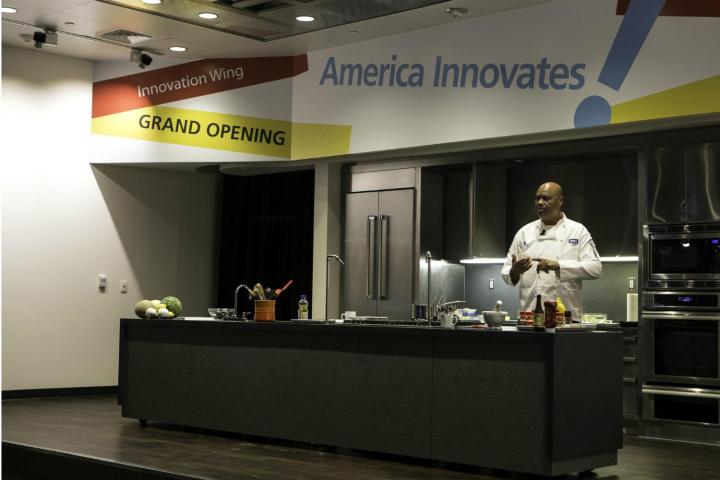
The demonstration kitchen opened July 3, kicking off a slew of programs that mix food and history. “Our goal with the space is really to use food to help people make connections to American history. For us, food is a way to help understand more about American history and how they fit into it. We really see food as a gateway to learning more about history,” Susan Evans, program director of the American Food History Project, tells Digital Trends.
The museum’s 5 million annual visitors will now be able to drop by the kitchen to see guest chefs in action on Food Fridays. Each month, there’s a different theme; the chefs work with Smithsonian staff to select recipes that reflect the theme. “The guests chefs frequently will their bring own stories and more modern techniques, and the Smithsonian staff person helps to make that connection between modern foods and the history of eating them,” Evans says.
When chef Curtis Aikens made dry-rubbed baby-back ribs and all-American roasted potato salad on stage during the week focused on Southern barbecues and picnics, Smithsonian host Jessica Carbone explained where potatoes came from and were originally grown, and how they were transported around the world. She went through the history of the spices included in the dry rub and the differences between chilies and peppers. “We also talked about some of the social conventions of picnics,” said Evans. “By cooking potato salad, you can have a conversation about who was invited to Southern picnics, and who was excluded, and what that meant in society and how race relations were involved in what people ate and how they ate it.”
To make a museum-ready kitchen, the Smithsonian had to take a lot into consideration. First, the stage had to double as a performance space for a jazz orchestra on occasion, so the moveable island had to be easy to remove, though it’s hooked up for gas, water, and electricity. To minimize the potential damage to the museum’s collectables, there’s a huge fan that sucks up the smoke and smell.
The demo kitchen is also home to a regular program, Ask a Farmer, where visitors can watch a video stream of a farmer talking about his or her profession, then ask questions. All the programs tie into the year’s theme of innovation in food history, culminating in the Food History Weekend, which will take place October 22-24.
One interactive program the kitchen is putting on is the history of chocolate making, including preparing drinking chocolate like people did during the foundation of the United States. “Chocolate was actually part of the rations that soldiers received during the Revolutionary War,” says Evans. “People didn’t start eating chocolate until the middle of 1800s, and that was really because of a texture issue.” The drinking chocolate would’ve been less sweet and more chalky than we’re used to, because there was less cocoa butter involved in the processing. “It was actually thought to be very very healthy,” says Evans of the chocolate rations. “If you went to the doctor, they would prescribe you chocolate” for your stomach problems or lethargy. “It would kickstart your day.”
Visitors get to see the tools used in making the drinking chocolate and help roast and grind the beans and spices, then melt the chocolate onto the metate, a stone used for heating the substances. “We know that people learn from doing things, so we want to get people doing things and thinking about their role in making history,” says Evans. Unfortunately, during neither the Food Fridays nor the daily demonstrations can visitors sample the wares (that may be a good thing for the drinking chocolate), though the cafes do try to make their menus reflect what’s cooking in the demo kitchen.
The recipes are also available on the Smithsonian’s website. “When you see someone and then you participate in a process that was done in a different time period, it helps you connect with the idea that there were real people who did things in history,” says Evans, “and then, hopefully, make the leap that in doing these things today, you are also part of making history.”





